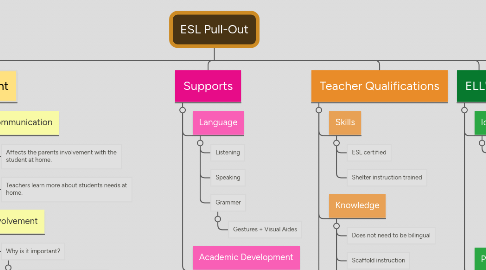
1. Parent
1.1. Communication
1.1.1. Affects the parents involvement with the student at home.
1.1.2. Teachers learn more about students needs at home.
1.2. Involvement
1.2.1. Why is it important?
1.2.1.1. Improves student achievment
1.2.1.2. Students earn higher grades
1.2.1.3. Parents know the level of progress their child is at
1.2.1.3.1. Can help or get academic help for their child faster
2. Supports
2.1. Language
2.1.1. Listening
2.1.2. Speaking
2.1.3. Grammer
2.1.3.1. Gestures + Visual Aides
2.2. Academic Development
2.2.1. Reading
2.2.2. Writing
2.2.3. Study Skills
2.2.4. Content Vocabulary
3. ELL's
3.1. Identified
3.1.1. Language proficiency level
3.1.1.1. Testing
3.1.1.1.1. Home Language Survey
3.1.1.1.2. AZELLA
3.2. Placed
3.2.1. Tested
3.2.2. Parent is Adviced
3.2.2.1. Parent has the option to decline or accept placement into an English immersion program
3.2.3. Student is placed in a program
3.2.4. Student is reassesed
3.3. Excited
3.3.1. If the student tests proficient in English
3.3.2. Placed in a mainstream classroom
3.4. Time
3.4.1. Monitored for two years
4. Teacher Qualifications
4.1. Skills
4.1.1. ESL certified
4.1.2. Shelter instruction trained
4.2. Knowledge
4.2.1. Does not need to be bilingual
4.2.2. Scaffold instruction
4.2.3. Know about different cultures
4.3. Attitudes
4.3.1. Positive
4.3.2. Patient
4.3.3. Collaboration
5. Why?
5.1. Class
5.1.1. Class sizes are smaller
5.1.2. Student's receive more attention
5.1.2.1. constructive feedback in language aquisition
6. Definition
6.1. ESL Pull-Out Program
6.1.1. The student is pulled out of the regular classroom for special instruction in ESL either 1-on 1 or small group instruction.
